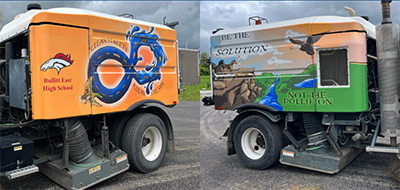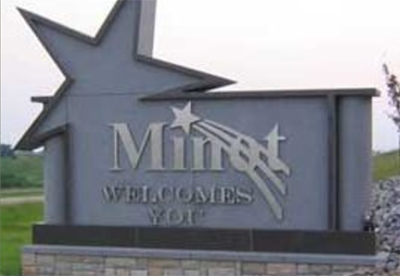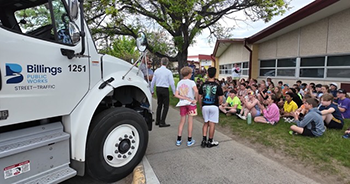The Power of Community Engagement in Street Sweeping ProgramsMunicipal street sweeping is a frontline defense for urban water quality and environmental health, yet its success hinges not just on equipment and schedules, but on the active participation and understanding of the community. Engaging citizens – especially youth – in these programs transforms routine maintenance into a shared civic mission, amplifying environmental awareness and fostering a culture of stewardship. |
|
by Ranger Kidwell-Ross
Two core strategies drive community engagement: educating the public, particularly children, about the environmental impact of street sweeping, and using creative outreach – such as naming contests and art projects – to make these efforts visible, relatable and supported. When residents understand why it matters to move their cars for sweepers or celebrate a newly wrapped vehicle, they become allies in keeping streets and waterways clean. Story 1: Bullitt East High School's Street Sweeper Wrap – Creativity Meets Civic Responsibility

In Mount Washington, Kentucky, Bullitt East High School (BEHS) art students partnered with the city to design a custom wrap for a new street sweeper, turning a utilitarian vehicle into a rolling symbol of community pride and environmental action. This real-world project allowed students to learn firsthand about the role of street sweepers in reducing pollution and protecting local waterways. By merging their artistic talents with environmental messaging, the students created a vibrant, visual reminder of civic responsibility. The project's impact extended beyond the classroom. Unveiled first at the school and then at the Mount Washington Spring Festival, the sweeper became a focal point for community celebration. Key student contributors, like Seth Bishop and Siarra Ricketts, exemplified how empowering youth voices leads to innovative solutions and a sense of ownership. The initiative embodied the district's Graduate Profile, positioning students as both innovative problem solvers and community contributors. The end result: cleaner streets, heightened environmental awareness, and a stronger sense of local identity, all sparked by student creativity and collaboration. Story 2: Minot's National Public Works Week – Demystifying Public Works Through Hands-On Engagement

For children, the event was both fun and informative: a plow blade for drawing, coloring books, comic books, and prize giveaways, including the chance for two lucky kids to ride in a sanitation truck or street sweeper. These activities not only entertained but also educated, giving young attendees a tangible connection to the machinery and people who keep their city running. By inviting the public to see, touch, and ask questions about street sweepers and other equipment, Minot's Public Works Department fostered appreciation and understanding—crucial for building long-term community support for street sweeping and related services. Story 3: Billings' Street Sweeper Naming Contest – Ownership, Education, and Environmental Impact

Conclusion: Best Practices and Lessons for Community EngagementThese three initiatives—art projects, open houses, and naming contests—demonstrate that the most effective street sweeping programs are those that invite the community in, especially its youngest members. Key lessons for cities include:
By involving youth and celebrating their contributions, cities plant the seeds for lifelong civic participation. Children who feel their ideas matter are more likely to grow into adults who care about and cooperate with community initiatives. |
© 2005 - 2025 World Sweeper
|
Street Contents
|